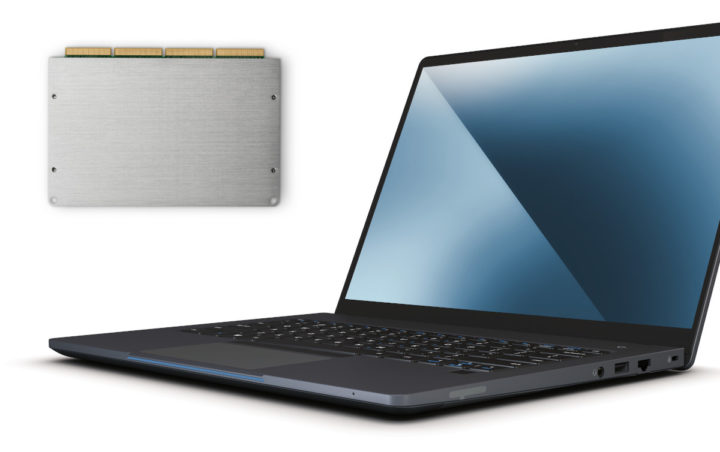Intel NUC P14E Laptop Element is a 13-9-inch modular laptop equipped with the same Intel NUC 11 Compute Element found in the Intel NUC 11 Enthusiast Phantom Canyon NUC11PHKi7C.
The NUC 11 Compute Element “Elk Bay” is a U-Series Compute Element (95 x 65 x 6 mm) offered with a choice of Tiger Lake processors ranging from an Intel Celeron 6305 chip to a Core i7-1185G7 processor combined with up to 16GB RAM. The card also includes a WiFi 6 and Bluetooth 5.2 module, a Gigabit Ethernet transceiver, and supports PCIe x4 Gen 3 and Thunderbolt 4.
Intel NUC P14E Laptop Element (CMCN1CC) specifications:
- Computer module – NUC 11 Compute Element with
- 11th generation Tiger Lake Celeron to Core-i7 processor
- 4 GB to 16 GB LPDDR4x 4266 MHz
- 256 Mbit Flash EEPROM with Intel Platform Innovation Framework for EFI Plug and Play
- Intel AX201 wireless module for WiFi 6 up to 2.4 Gbps and Bluetooth 5.1 connectivity
- Storage – 1x M.2 22×42/22×80 slot for PCIe x4 Gen4 NVMe SSD
- Display – 13.9-inch 3000×2000 IPS display with IPS 3:2 ratio, 400nit, 100% sRGB, and touchscreen
- Video Output – HDMI 2.0b, DisplayPort 1.4a
- Camera – HD IR Camera with support for Windows Hello
- Audio – 3.5 mm stereo headset jack, Intel HD Premium Audio
- Connectivity – Gigabit Ethernet port, plus wireless module integrated into Compute Element
- USB – 1x Thunderbolt 4/USB4.0 Type-C port, 2x USB 3.2 Gen2 Type-A ports
- Backlit keyboard with pointing stick, Glass click pad, RGB light bar
- Misc – Kensington NanoSaver Lock, fingerprint reader
- Battery – 77 Whr Battery with fast charging support
- Power Supply – 65W USB-C Power Adapter
- Dimensions – 303.6 x 229.4 x 16.55mm (Anodized aluminum chassis)
- Weight – 1.5 kg
 Intel only mentions Windows 10 in the “list” of supported operating systems, but Ian’s tested Linux on the Intel NUC 11 Enthusiast Phantom Canyon successfully earlier this year. Both NUC Software Studio and NUC Audio Studio programs can be used with the laptop.
Intel only mentions Windows 10 in the “list” of supported operating systems, but Ian’s tested Linux on the Intel NUC 11 Enthusiast Phantom Canyon successfully earlier this year. Both NUC Software Studio and NUC Audio Studio programs can be used with the laptop.
The solution should enable users to switch to another Compute Element either to upgrade the processor or replace a broken card. If Intel does not kill the Compute Element family altogether, as they did for the Compute Card, you may even be able to upgrade to a module with a 12th generation processor once they come out.
More details may be found on Intel’s NUC laptop kits page and a product brief.
Via Liliputing

Jean-Luc started CNX Software in 2010 as a part-time endeavor, before quitting his job as a software engineering manager, and starting to write daily news, and reviews full time later in 2011.
Support CNX Software! Donate via cryptocurrencies, become a Patron on Patreon, or purchase goods on Amazon or Aliexpress. We also use affiliate links in articles to earn commissions if you make a purchase after clicking on those links.






So yeah, Intel killed the Compute Card, but the Compute Element will totally survive.
I guess if there were an aftermarket for second hand compute elements.
e.g. today I buy the base Celeron element for home, while a business user buys the fully specced Core i7. In 2-3 years time, he writes it off as depreciation and buys a new compute element. I upgrade with that 2nd hand element at a massive discount.
There is also a reverse possibility – if you smash the screen or otherwise damage the shell/dock/whatever this is, your compute element is still there.
I hade real hopes in compute card/element. It’s the only way to cut down e-waste. I really wish OEMs would embrace it..
I agree but it’s as much unlikely as you don’t see socketted CPUs anymore in laptops. Even RAM is often soldered to make sure you can’t upgrade it. There’s too much money to make by selling a full-blown device with storage and screen when the user only wanted a RAM expansion. There’s no mystery, laptop prices were divided by 10-20 in 20 years, thanks to fierce competition. If we want to be able to get some at such low prices, vendors have to figure ways to force you to buy more often 🙁 In the end we’re always the ones having to pay anyway.
> Even RAM is often soldered to make sure you can’t upgrade it
Do you have a source for LPDDR4 or even LPDDR4x SO-DIMMs? Exactly, me neither. There exist a lot of reasons for soldered components in laptops other than preventing upgradability.
These days we’re gradually replacing MacBooks from 2012 with recent M1 thingies. Some of them received a new battery, none of them got CPU or RAM upgrades for obvious reasons: both CPU and DDR3L chips are soldered. And users are/were fine with them since for their use cases they were all the time ‘fast enough’. Now the M1 CPUs are 3-4 times faster than the Ivy Bridge stuff from a decade ago but that’s totally irrelevant since still ‘fast enough’ but at a fraction of consumption. For our users the most important change will be the way longer time running on battery especially when next macOS release implements a ‘low power’ mode sending everything CPU to the ARM efficiency cores (if I understood correctly).
Wrt amount of RAM: even if Apple always charged and still charges insane amounts of money for RAM upgrades, it simply doesn’t matter to pay few hundred bucks more for 8GB or 16GB since in the end that’s just a few bucks per month when talking about using these things for 6-9 years as we always do…
When you buy a computer, you buy one with the ability to upgrade RAM or you guess how much RAM you will need near the end of its imagined life.
You either over-provision or you risk a shorter life.
And yes, manufacturers mark-up on RAM is high. Apple M1 RAM markups are insane – that’s why I don’t have one.
> or you guess how much RAM you will need near the end of its imagined life.
To help with this you (or at least I) start to monitor RAM usage of your client machines just to realise that vast majority of our users would still be fine with 8GB RAM. Apple adding transparent memory compression to macOS few years ago clearly had a benefit in this regard.
> Dimensions – 303.6 x 229.4 x 116.5mm
That would not be a laptop but a massive brick. The height is 16.55 mm according to Intel’s product brief which (judging by the picture) seems to be not true or at least not the height of the whole thing measured with lid closed.
Thicker because from the photo, the module is enclosed within a piece of metal acting as a passive heatsink – versus a traditional fan-cooled laptop.